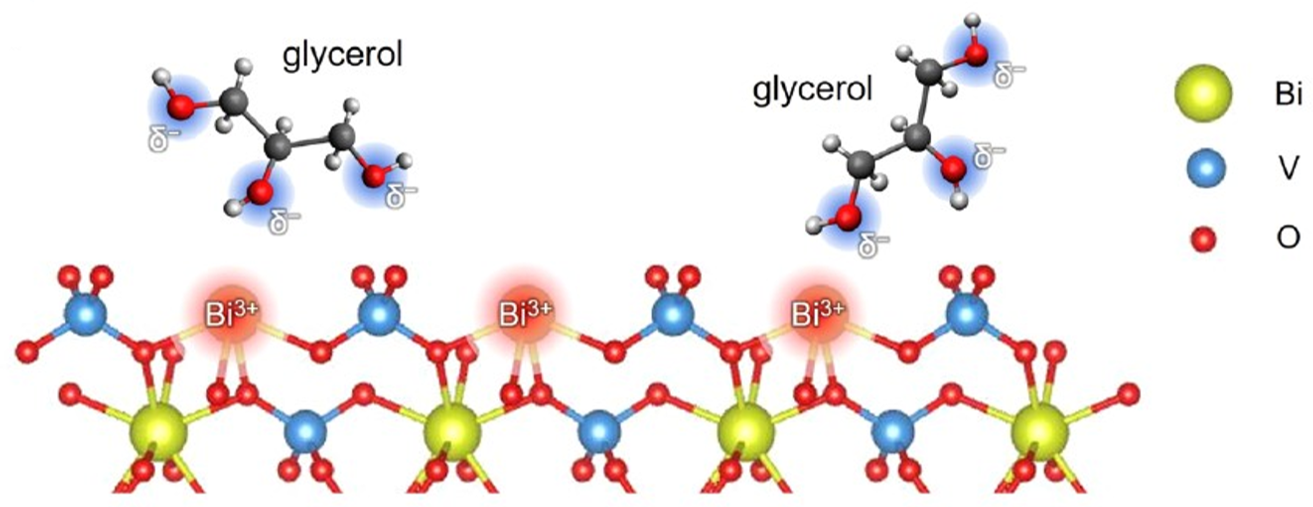Researchers at Helmholtz-Zentrum Berlin’s Institute for Solar Fuels have investigated the influence of electrolytes on the efficiency of the glycerol oxidation reaction. These findings could contribute to developing more efficient and environmentally friendly production processes.
 The glycerol’s hydroxyl groups are attracted to the Bi3+ ions on the surface of the BiVO4 photoanode. The electrolyte plays a decisive role in mediating these interactions. Image Credit: HZB
The glycerol’s hydroxyl groups are attracted to the Bi3+ ions on the surface of the BiVO4 photoanode. The electrolyte plays a decisive role in mediating these interactions. Image Credit: HZB
Glycerol is a byproduct of the conversion of biomass to biodiesel that is produced in large quantities. Even though this by-product can be converted into more valuable chemicals by oxidation in photoelectrochemical reactors, it has not been used much up to this point due to low selectivity and efficiency.
The European Union produced about 16 billion liters of biodiesel and HVO diesel in 2023 using either maize, rapeseed, or a portion of agricultural waste materials. Glycerol, a byproduct of the synthesis of biodiesel, can be utilized as a building block in the glycerol oxidation reaction (GOR) to produce valuable chemicals like dihydroxyacetone, formic acid, glyceraldehyde, and glycolaldehyde.
Glycerol can be oxidized electrochemically in (photo)electrochemical (PEC) reactors, which are currently being developed primarily for the production of green hydrogen. However, this approach in PEC plants is still scarcely utilized despite its potential to significantly increase the economic efficiency of the PEC Power-to-X process. Glycerol oxidation requires much less energy input than hydrogen production through water splitting while simultaneously producing more valuable chemicals.
Examining the Influence of Different Electrolytes
Numerous investigations have already been conducted on the function of photocatalysts in PEC electrolyzers; however, the electrolyte’s function has not yet been thoroughly examined.
The researchers employed a PEC cell with nanoporous bismuth vanadate (BiVO4) photoanodes. In acidic electrolytes (pH = 2), they tested a variety of cations and anions, such as sodium nitrate (NaNO3), sodium perchlorate (NaClO4), sodium sulfate (Na2SO4), potassium sulfate (K2SO4), and potassium phosphate (KPi).
Our results showed that BiVO4 photoanodes perform best in NaNO3 and outperform the commonly used Na2SO4 in terms of photocurrent, stability, and production rates of high-quality glycerol oxidation reaction products.
Dr. Marco Favaro, Institute for Solar Fuels, Helmholtz-Zentrum Berlin
Sodium Nitrate Performs Best
The team also investigated the causes of the performance differences and concluded that the ions' varied sizes, pH buffering capacities, and salting in/out capabilities (Hofmeister series) were important factors.
The composition of the electrolyte has a surprising clear effect on the glycerol oxidation efficiency, and we were able to observe this trend in both bismuth vanadate and polycrystalline platinum anodes.
Heejung Kong, Ph.D. Student, Helmholtz-Zentrum Berlin
This supports the assumption that these findings could apply to different materials and processes.
Therefore, the choice of electrolyte is of great importance for the efficiency and stability of glycerol oxidation.
Our research could help to convert biomass by-products into valuable chemicals more efficiently and to produce valuable chemicals from waste materials while minimizing the impact on the environment.
Dr. Marco Favaro, Institute for Solar Fuels, Helmholtz-Zentrum Berlin